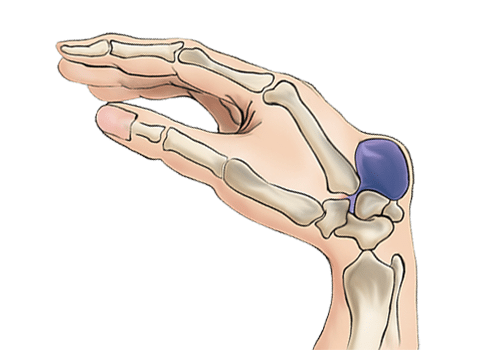What are Ganglion Cysts?
 A Ganglion cyst typically occurs near the joints or tendons of your hands or wrist. They are noncancerous lumps ranging in size from dime size to an inch in diameter. These types of cysts are also filled with a jelly-like fluid and round in size.
A Ganglion cyst typically occurs near the joints or tendons of your hands or wrist. They are noncancerous lumps ranging in size from dime size to an inch in diameter. These types of cysts are also filled with a jelly-like fluid and round in size.
Normally these cysts don’t cause pain. However, when the lump adds pressure to a nearby nerve it may become pinched and cause pain. At times the location of this small jelly-like lump may interfere with joint movement and cause joint pain.
Ganglion Cysts are usually ok left untreated. Although, If the lump becomes painful due to a nearby nerve or interferes with your joint movement, it is a good idea to look into draining the cyst. Another option is to move the cyst altogether. But in many cases, the cyst will go away on its own.
Ganglion Cyst Symptoms
When a cyst appears on your wrist, it is characterized by the shape, location, and pain, such as:
- Shape and size. Ganglion cysts are round or oval and usually measure less than an inch (2.5 centimeters) in diameter. Some are so small that they can’t be felt. The size of a cyst can fluctuate, often getting larger when you use that joint for repetitive motions.
- Location. The cysts most commonly develop near the tendons or joints of your wrists or hands. The next most common locations are the ankles and feet. These cysts can occur near other joints as well.
- Pain. Ganglion cysts usually are painless. However, if a cyst presses on a nerve — even if the cyst is too small to form a noticeable lump — it can cause hand pain, tingling, numbness, or muscle weakness.
Ganglion Cyst Causes
At this time, we don’t know why a ganglion cyst develops. We do know though that it grows out of the lining of a tendon or a joint. It appears like a tiny water balloon or stalks surrounding the joint or tendon that bulges out of place. Inside of the cyst is a thick fluid, such as fluid found in joints or around tendons.
Although we do not know the cause, there are certain factors that increase your risk, such as:
Osteoarthritis: If you have osteoarthritis the risk of developing a cyst increases. This is due to the wear-and-tear in the finger joints and often occur near these joints.
Age & Sex: Although these cysts can occur in anyone, they are most common in women between the ages of 20 and 40.
Previous Tendon or Joint Injury: If you’ve had a joint or tendon injury in the past, you are more likely to develop a ganglion cyst.
Treatment for the Cyst
The good thing is that ganglion cysts are normally painless and require no treatment. Although they are important to keep a close eye on, just in case it starts to interfere with joint movement and become painful.
Aspiration
During this procedure, a physician will use a needle to drain the fluid from the cyst. But it is possible for the cyst to reoccur.
Immobilization
Although to cause is unknown, we do know that activity seems to enlarge the cysts. So immobilization will help keep the area still while the cyst shrinks and relieves pressure. It’s important to avoid long term use so your muscles do not weaken.
Surgery
If all other options have been exhausted and failed, surgery may be the next treatment. The doctor removes the cyst and the stalk that attaches the joint to the tendon during the procedure. It’s uncommon for the surrounding nerves to be injured from this procedure. However, it is possible for the cyst to reoccur even after surgical intervention.
If you are experiencing a Ganglion Cyst with pain or pressure on a nearby joint, call us at 888-409-8006.
